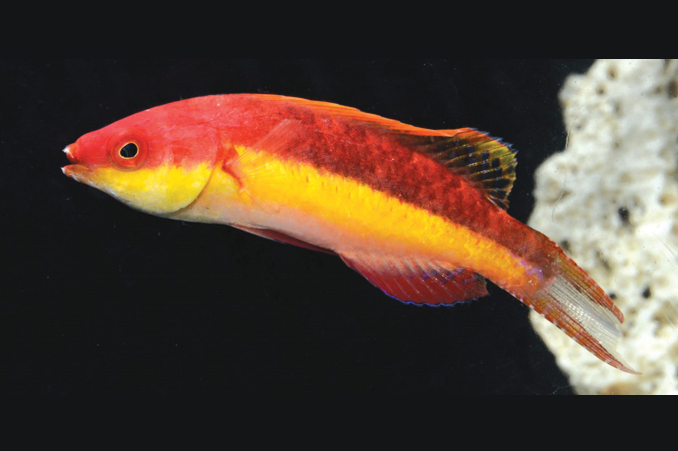Sunset Fairy-wrasse, Cirrhilabrus greeni Allen & Hammer 2017

Holotype of the Sunset Fairy-wrasse, Cirrhilabrus greeni, a terminal phase male, from the eastern Timor Sea, Northern Territory, photographed in an aquarium. Source: Michael P. Hammer, in Allen & Hammer (2017) Journal of the Ocean Science Foundation 29: 60, Fig 3. License: CC BY Attribution
Summary:
Males are pink to reddish on the upper half of the head and body, bright yellow below, with a mainly yellowish-orange dorsal fin, a scarlet-red anal fin, and a distinctive emarginate caudal fin that appears lunate due to a clear central portion and tapering red bands along the upper and lower margins. Females have a large black spot on the upper part of the caudal peduncle.
Cite this page as:
Bray, D.J. 2017, Cirrhilabrus greeni in Fishes of Australia, accessed 20 Apr 2024, https://fishesofaustralia.net.au/home/species/5393
Sunset Fairy-wrasse, Cirrhilabrus greeni Allen & Hammer 2017
More Info
|
Distribution |
Eastern Timor Sea, approximately 300 km northwest of Darwin, Northern Territory, Australia and 300 km southwest of the Tanimbar Islands, Indonesia. Inhabits sloping rubble bottoms with scattered low rocky or coral outcrops and occasional large coral outcrops. The Sunset Fairy-wrasse co-occurs with several other members of the genus Cirrhilabrus. |
|
Features |
Dorsal fin XI, 9; Anal fin III, 9; Pectoral fin 15; Lateral-line interupted, pored scales 16–17 + 6–7; Caudal fin (principal rays) 13, uppermost and lowermost rays unbranched; Procurrent caudal fin rays (upper and lower rays) 4-6, posterior-most rays segmented; Gill rakers 13-14, pseudobranchial filaments 11; Branchiostegal rays 5; Vertebrae 24-25. Greatest body depth 3.6–3.7 in SL; body compressed, width 1.8–2.1 in depth; dorsal profile of head nearly straight, becoming slightly convex on nape; head length 2.9–3.0 in SL; snout length 3.5–4.3 in HL; orbit diameter 3.3–3.9 in HL; interorbital width 4.3–4.6 in HL; caudal-peduncle depth 2.2–2.5 in HL; caudal-peduncle length 1.9–2.8 in HL. Dorsal fin mostly uniform in height; pelvic fins of TP male moderately elongate, reaching posteriorly to about base of first soft anal-fin ray, 2.7–3.9 in SL; caudal fin distinctly emarginate, appearing lunate in males due to tapering red bands along dorsal and ventral margins. Scales above lateral line to origin of dorsal fin 2; scales below lateral line to anus 6; median predorsal scales 5; median preventral scales 5; single horizontal scale row on cheek; circumpeduncular scales 14. |
|
Colour |
TP males: upper half of body (area above line connecting upper rear edge of gill cover and middle of caudal-fin base) pink to reddish-brown, ventral half of body bright yellow; head above level of lower edge of eye scarlet red, below level abruptly yellow, narrow elongated patch of blue along ventral aspect from chin to pelvic-fin base; eye with red iris and thin yellow ring around pupil; dorsal fin yellow orange, except first spine dark brown and brownish area on basal part of posterior half of fin, also series of translucent spots of variable size (sometimes merged), just above brownish area; anal fin scarlet red with fine black outer margin and 1–2 rows of brown spots or ocelli markings at base of posterior half of fin; caudal fin translucent medially with tapering red bands along dorsal and ventral margins; pelvic fins red; pectoral fins translucent with red base, also red area immediately above pectoral-fin base, confluent with red color of head. Nuptial-display changes in coloration are unknown. Females: upper two-thirds of head and body pinkish red, with faint red to lavender stripe on each horizontal scale row, grading to slightly yellowish or whitish ventrally; a black spot, about one-third to half pupil size, on upper side of caudal peduncle; eye with pale yellow to whitish iris; dorsal fin yellowish with brown first dorsal-fin spine and oblique dark-edged translucent bands; anal fin pinkish with similar oblique bands as those on dorsal fin; caudal fin pinkish red basally, grading to translucent with faint reddish bands (and intense red “checkering”) on basal part of dorsal and ventral margins; pelvic fins pale pinkish; pectoral fins translucent with conspicuous yellow base. |
|
Feeding |
|
|
Similar Species |
Differs from all other species of Cirrhilabrus in having tapering red bands along dorsal and ventral margins of the caudal fin, giving the fin a lunate appearance in TP males. Although Cirrhilabrus brunneus from the Indo-Malayan region and C. lunatus from Japan, have a strongly emarginate to lunate caudal fin, they differ markedly in color pattern. The bicolour pattern with red above the lateral midline and bright yellow below is also unique among Cirrhilabrus species. Although females of many Cirrhilabrus species look similar, the position and size of the black spot on the caudal peduncle high on the body and about one scale wide readily distinguishes female C. greeni from sympatric congeners, especially the common C. hygroxerus (with a tiny spot), from the collection site. |
|
Species Citation |
The species is named in honour of Tim Green of Monsoon Aquatics (Darwin, Australia), who collected the type specimens. |
|
Author |
Bray, D.J. 2017 |
Sunset Fairy-wrasse, Cirrhilabrus greeni Allen & Hammer 2017
References
Allen, G.R. & Hammer, M.P. 2017. Cirrhilabrus greeni, a new species of wrasse (Pisces: Labridae) from the Timor Sea, northern Australia. Journal of the Ocean Science Foundation 29: 55–65. doi: http://dx.doi.org/10.5281/zenodo.1115674 Open access





